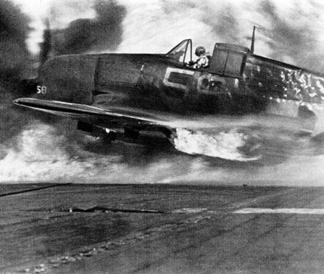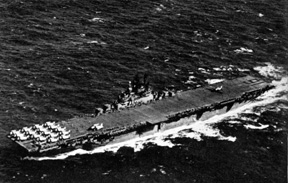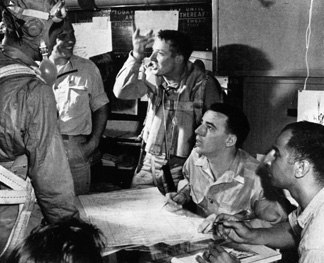|
U.S. Naval Aviation In the South Pacific during WW II Featuring the Lexington Aircraft Carrier The Battle of the Marianas — June 1944 Chapter 3 Page 5 of 7 Pages |
||||||||||
| Shortly after starting back toward our ship, the oil pressure gauge in the cockpit was indicating a problem. I let Sterrie know that and that I might have to drop out at any time. Linson heard me call Sterrie. He then tried to talk to me on the intercom. I heard him and responded but Linson could not hear me. Linson, realizing that he could not hear me on the intercom crawled forward to the center cockpit immediately aft of the pilot and handed me a written message. He said he had heard my message to Sterrie regarding the oil pressure problem. He had further written, "if you want us to bail out blink the arm-master switch 3 times, or twice to get set for a water landing." The arm-master switch when activated shows a red light in the tunnel of the plane where the radioman is located. I wrote back to Linson, "Okay, oil pressure up and engine acting up be ready for anything." Linson crawled back through the tunnel and pushed the note pad to Banazak in the gun turret. Banazak turned on his light and read the message and handed it back to Linson with a "thumbs up," understood. Sixty miles from the Lexington Sterrie picked up the homing signal from the ship. At 8:30 pm the first visual contact with our TF was made. |
||||||||||
| Sterrie led our 5 Avengers across the TF screen and started to search for the identifying glow light of the Lexington. We were flying now at about 500 feet and finding ourselves dodging other single and groups of planes doing the same thing we were doing, trying to find the right ship. Sterrie went back up to 1000 feet to try to avoid some of the traffic. In the change of altitude, Cushman and Thomas disappeared. After awhile Sterrie dropped down to 500 feet again, located the Lexington and broke off into the landing pattern and landed aboard. Getting into the landing pattern turned out to be a real chore. The order had been given to land on any available carrier. |
||||||||||
 |
||||||||||
|
Ctsy. LPHOWWII |
||||||||||
| Everybody by this time was running on empty or near empty. When I was finally able to safely maneuver into the landing pattern and turn on the downwind leg of the approach I could see that the deck of the Lexington was fouled and she was not taking on planes. I made two more passes with the hope that the fouled deck would be cleared. It did not clear and all of my fuel gauges now showed empty. To go looking for another carrier was an option but not my favorite with the fuel situation what it was. We had been trained that if you thought you would have to make a water landing, do it while you still had power if at all possible. |
||||||||||
 |
||||||||||
|
Photo Ctsy: Mission Beyond Darkness by Bryan and Reed |
||||||||||
| I reached down and flicked the arm-master switch twice. This was the prearranged signal for the crew to prepare for a water landing. Banazak saw the reflection of the arm-master switch light in his Plexiglas turret. He knew what was about to happen. He took off his parachute harness and unlocked the escape hatch which would allow him to go out the port side of the plane and get to the wing on the opposite side from where Linson and I would be. Linson climbed into the middle cockpit. The crew was now in position for a water landing. Up ahead and to my port I saw one of our TF Destroyers. By now, I had the flaps down. The landing gear remained in the up position. I made my last change of direction toward the destroyer blinking my running lights with the hope of attracting someone's attention, and allowed the plane to settle slowly down toward the water. The reflection from the exhaust flames from the engine became brighter and brighter against the water as we came closer to the surface of the water. The plane hit and crushed to a stop with water spraying up over the cockpit and the wings of the plane. For a moment it seemed like the plane would go right up on its nose, but then it settled back and actually floated for a matter of seconds. By the time I got out on the starboard wing Linson was already there and had the hatch to the life raft storage compartment off. Banazak was on the port wing, had taken off the hatch on that side to assist in pushing the raft out on the starboard wing. When he discovered the raft was already out he jumped over the cockpit to the starboard wing. Our next task was to inflate the raft and board it hopefully before the plane fell out below us. There was no moon and at the moment no artificial source of light. It was dark! Unfortunately we inflated the life raft upside down and had no time to do anything about it then as the plane sank away from us. We were holding on to the raft and decided we would be better off to inflate our life jackets that we each were wearing. This solved the problem of staying above the water for the moment. I had a flashlight that was attached to my life jacket. I started waiving the light as high above the water as I could reach and blew the whistle as loud and long as I could. We were in the water only a few minutes when we heard a voice from the destroyer call out, "hold on! we'll be right back." |
||||||||||
| We were all a little disappointed that we had not been picked up by the ship that we had picked out to be our rescuer. We made some efforts to turn the raft right side up but found that there was practically no wind to assist us in that effort and finally decided to just hold on to it and rest. I think that it was about at this point that the energy level of all three of us had reached the empty point on our own gauges.
We had been in the water about twenty minutes when we saw a second ship approaching. We could see search lights from the deck of the ship playing out over the ocean in all directions. |
||||||||||
 |
||||||||||
|
Ctsy. Life Inc. |
||||||||||
| We started the flashlight and the whistle routine again with a few shouts mixed in. Finally the lights honed in on us. I can tell you that at that point there were three very wet but happy flyers. The ship turned out to be the light cruiser, USS Reno. It put a whale boat over the side and came out and picked us up and took us aboard. We were immediately taken to sickbay and checked over. They wanted to know who we were and what ship we were from. We were then allowed to try and get some sleep. Sleep was hard to come by for me. The events of the day and night kept replaying over and over again; always with the continuing doubts about the decisions I had made and concern for the safety of those whom we knew had encountered difficulty both before and during the strike. The next day we were transferred from the Reno to a destroyer that delivered us by breeches buoy to the Lexington. Sterrie was on the hangar deck to greet us when we came aboard. I inquired about those of our squadron that I feared had been lost. He smiled and said Mac and crew were picked up earlier today and all are fine, Buzzie had a successful water landing, Cush, Swanny and I landed here and Bill was able to land on the Enterprise. So we are all accounted for. Chapter 3— End of Page 5 of 7 Pages — Go to Page 6 Page —1 — 2 — 3 — 4 — 5 — 6 — 7 Or This Story’s Cover Page — Editor’s Introduction — Table of Contents Fred Gwynn’s “Torpedo 16” — Chapter — 1 — 2 — 3 — 4 Or Home - Contact Us - Cold War Hist. - 91st SRS Hist. - Stardust 40 Mission Story |
||||||||||